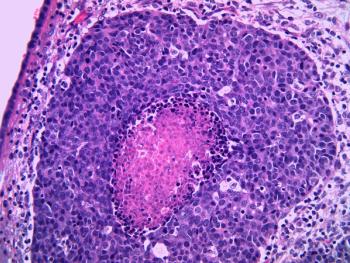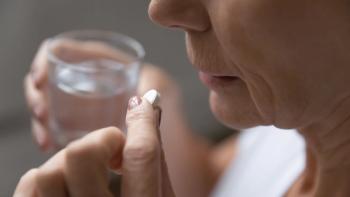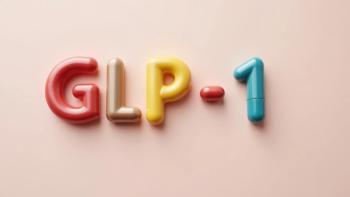
Oral Therapy Approved to Treat Heavy Menstrual Bleeding Associated with Uterine Fibroids in Pre-menopausal Women
Uterine fibroids, also known as leiomyomas, are the most common type of benign tumors in women of reproductive age.
This article was provided and sponsored by AbbVie Inc.
Uterine Fibroids Overview
Uterine fibroids, also known as leiomyomas, are the most common type of benign tumors in women of reproductive age, affecting up to 70 percent of Caucasian women and 80 percent of African-American women by age 50.1-3 Originating in the muscle tissue of the uterus, fibroids primarily grow in the intramural space, or within the wall, of the uterus. While the exact cause of uterine fibroids remains unknown, genetics and the levels of female sex hormones estrogen and progesterone may be contributing factors.4 For some patients, uterine fibroids are completely asymptomatic, while approximately 30-40 percent of patients experience a variety of symptoms, depending on the size and location of the fibroid.5,6 The most common symptom is excessive menstrual bleeding.2,3
The management and treatment of uterine fibroids should be based on individual patient factors and treatment goals. Disease management for fibroids has primarily relied on surgical procedures, such as hysterectomy or myomectomy,3,4 with uterine fibroids being the leading indication for hysterectomies performed in the United States.7-9 The use of NSAIDS, gonadotropin-releasing hormone receptor (GnRH) agonists or oral contraceptives are some of the medical treatment options used to manage uterine fibroids.10
The Burden of Uterine Fibroids
Heavy menstrual bleeding due to uterine fibroids can interfere with a patient’s daily activities, relationships with family, friends and loved ones, and work.11 For patients with fibroids, heavy bleeding is the most important reason for seeking treatment*,12,13 with 65 percent of patients with symptomatic fibroids reporting that they worry about bleeding accidents through their clothes or bedding†).11
*From patient survey data collected from June 30 - September 6, 2016 where women over 18 years of age reported relief from heavy bleeding as the most important aspect of fibroid treatment across all 3 cohorts - at-risk (n=300), diagnosed (n=871), and fibroid-related hysterectomy (n=272).
†A total of 968 women (621 white, 272 African American, 75 other races) aged 29-59 years with self-reported symptomatic uterine leiomyomas participated in a US national survey conducted from December 2011 to January 2012. Diagnosis, information seeking, attitudes about fertility, impact on work, and treatment preferences were assessed.
A Nonsurgical Treatment Option14
ORIAHNN™(elagolix/estradiol/norethindrone acetate; elagolix) is the first and only FDA-approved non-surgical, oral medication option for the management of heavy menstrual bleeding associated with uterine fibroids in pre-menopausal women. Use of ORIAHNN should be limited to 24 months due to the risk of continued bone loss, which may not be reversible. ORIAHNN may increase chances of heart attack, stroke, or blood clots, especially for patients who are smokers over 35 years of age with high blood pressure. Please see the important safety information, including boxed warning on thromboembolic disorders and vascular events, below.
Safety Considerations14
Estrogen and progestin combinations, including ORIAHNN, increase the risk of thrombotic or thromboembolic disorders, including pulmonary embolism, deep vein thrombosis, stroke, and myocardial infarction, especially in women at increased risk for these events. ORIAHNN is contraindicated in women with current or a history of thrombotic or thromboembolic disorders and in women at increased risk for these events, including women over 35 years of age who smoke and women with uncontrolled hypertension.
How ORIAHNN Works
Elagolix inhibits endogenous GnRH signaling in the pituitary gland, suppressing luteinizing hormone (LH) and follicle-stimulating hormone (FSH), which leads to a decrease in the production of estradiol and progesterone. This reduction in hormone levels ultimately reduces bleeding associated with uterine fibroids. The addition of E2/NETA to elagolix in ORIAHNN is intended to help achieve a balance between the reduction of heavy bleeding and associated hypoestrogenic side effects.
The Role of the Pharmacist in Treating People with Uterine Fibroids
As with all medications, counseling is important for pharmacists when assessing a patient’s familiarity with medication-based therapy and can be an opportunity to further educate patients about the appropriate use of ORIAHNN. Important points of discussion to include during the counseling session are the dosing schedule, treatment expectations and safety information, including common side effects and potential drug interactions.15
Prior to ORIAHNN Use, Patients Should be Informed Appropriately14
- ORIAHNN should be started within seven days from the onset of the menstrual period, or when pregnancy is ruled out.
- ORIAHNN is taken twice daily, with or without food, and at approximately the same time each day.
- There are two capsule types within ORIAHNN blister pack. One capsule is taken in the morning, and the other is taken in the evening. The morning capsule (300 mg elagolix/1 mg estradiol/0.5 mg norethindrone acetate) is white and yellow, and the evening capsule (300 mg elagolix) is white and light blue. Patients should take each capsule at approximately the same time each day.
- If a dose is missed, it should be taken within four hours of the time it was supposed to be taken, and the next dose should be taken at the usual time. If more than 4 hours have passed, the patient should be instructed to not take the missed dose and take the next dose at the usual time. Only one morning capsule and one evening capsule should be taken per day.
- Patients should use nonhormonal contraception during treatment and for 1 week after discontinuing ORIAHNN.
- The most common side effects of ORIHANN include hot flushes, headache, fatigue and irregular periods.
- ORIAHNN should be limited to 24 months to limit the impact to bone health.
- Assessment of bone mineral density (BMD) by dual-energy X-ray absorptiometry (DXA) is recommended at baseline and periodically thereafter.
- Patient should avoid grapefruit and grapefruit juice during treatment with ORIAHNN since they may affect the level of ORIAHNN in the blood, which may increase side effects.
ORIAHNN is an oral medication that quickly controls heavy menstrual bleeding due to fibroids in premenopausal women. In clinical trials, a greater than 50 percent reduction in bleeding was seen by the end of Month 1 (menstrual blood loss reduction at Month 1 was a ranked secondary endpoint).16 ORIAHNN was studied in two six-month, replicate, double-blind, placebo-controlled studies of 790 premenopausal women aged 25 to 53 years old.14 All prespecified primary and ranked secondary endpoints were met with statistical significance.17 These study findings were published in the
For more safety information, please see the
Patient Resources
Resources are available to help reduce out-of-pocket costs for eligible patients. Eligible, commercially insured patients may pay as little as $5 per month†† using the
For any questions about Oriahnn Complete, patients can call 1-800-ORIAHNN (1-800-674-2466) or be directed to the
For more safety information, please see the
INDICATION
ORIAHNN™ (elagolix, estradiol, and norethindrone acetate capsules; elagolix capsules) is indicated for the management of heavy menstrual bleeding associated with uterine leiomyomas (fibroids) in premenopausal women. Use of ORIAHNN should be limited to 24 months due to the risk of continued bone loss, which may not be reversible.
IMPORTANT SAFETY INFORMATION
THROMBOEMBOLIC AND VASCULAR EVENTS
Estrogen and progestin combinations, including ORIAHNN, increase the risk of thrombotic or thromboembolic disorders, including pulmonary embolism, deep vein thrombosis, stroke, and myocardial infarction, especially in women at increased risk for these events.
ORIAHNN is contraindicated in women with current or a history of thrombotic or thromboembolic disorders and in women at increased risk for these events, including women over 35 years of age who smoke and women with uncontrolled hypertension.
CONTRAINDICATIONS
- ORIAHNN is contraindicated in women at a high risk of arterial, venous thrombotic, or thromboembolic disorders; who are pregnant; with known osteoporosis; current or history of breast cancer or other hormonally sensitive malignancies; known hepatic impairment or disease; undiagnosed abnormal uterine bleeding; known anaphylactic reaction, angioedema, or hypersensitivity to ingredients of ORIAHNN; or with concomitant use of organic anion transporting polypeptide (OATP) 1B1 inhibitors that are known or expected to significantly increase elagolix plasma concentrations.
WARNINGS AND PRECAUTIONS
Thromboembolic Disorders and Vascular Events
- ORIAHNN is contraindicated in women with current or a history of thrombotic or thromboembolic disorders and in women at increased risk for these events. Components of ORIAHNN increase the risk of thrombotic or thromboembolic disorders, including pulmonary embolism, deep vein thrombosis, stroke, and myocardial infarction, especially in women at high risk for these events. In general, the risk is greatest among women over 35 years of age who smoke, and women with uncontrolled hypertension, dyslipidemia, vascular disease, or obesity.
- Discontinue ORIAHNN if an arterial or venous thrombotic, cardiovascular, or cerebrovascular event occurs. If feasible, discontinue ORIAHNN at least 4 to 6 weeks before surgery of the type associated with an increased risk of thromboembolism, or during periods of prolonged immobilization. Stop ORIAHNN if there is sudden, unexplained partial or complete loss of vision, proptosis, diplopia, papilledema, or retinal vascular lesions and evaluate for retinal vein thrombosis immediately.
Bone Loss
- ORIAHNN is contraindicated in women with known osteoporosis. ORIAHNN may cause a decrease in bone mineral density (BMD) in some patients, which is greater with increasing duration of use and may not be completely reversible after stopping treatment.
- The impact of ORIAHNN-associated decreases in BMD on long-term bone health and future fracture risk is unknown. Consider the benefits and risks of ORIAHNN in patients with a history of low-trauma fracture or other risk factors for osteoporosis or bone loss, including those taking medications that may decrease BMD (e.g., systemic or chronic inhaled corticosteroids, anticonvulsants, or proton pump inhibitors).
- Assessment of BMD by dual-energy X-ray absorptiometry (DXA) is recommended at baseline and periodically thereafter. Consider discontinuing ORIAHNN if the risk associated with bone loss exceeds the potential benefit of treatment. Limit the duration of use to 24 months to reduce the extent of bone loss.
Hormonally Sensitive Malignancies
- ORIAHNN is contraindicated in women with current or a history of breast cancer and in women at increased risk for hormonally sensitive malignancies, such as those with mutations in BRCA genes.
- The use of estrogen alone and estrogen plus progestin has been reported to result in an increase in abnormal mammograms requiring further evaluation. Surveillance measures, such as breast examinations and regular mammography, are recommended. Discontinue ORIAHNN if a hormonally sensitive malignancy is diagnosed.
Suicidal Ideation, Suicidal Behavior, and Exacerbation of Mood Disorders
- Depression, depressed mood, and/or tearfulness were reported at a higher incidence in women taking ORIAHNN (3%) compared with placebo (1%) in the Phase 3 clinical trials. Suicidal ideation and behavior, including a completed suicide, occurred in women treated with lower doses of elagolix in clinical trials conducted for a different indication.
- Promptly evaluate patients with depressive symptoms to determine whether the risks of continued therapy outweigh the benefits. Patients with new or worsening depression, anxiety, or other mood changes should be referred to a mental health professional, as appropriate.
- Advise patients to seek immediate medical attention for suicidal ideation and behavior. Reevaluate the benefits and risks of continuing ORIAHNN if such events occur.
Hepatic Impairment and Transaminase Elevations
- ORIAHNN is contraindicated in women with known hepatic impairment or disease.
- Transaminase elevations in alanine aminotransferase (ALT) and aspartate aminotransferase (AST) occurred with ORIAHNN in Phase 3 clinical trials. No pattern in time to onset of these liver transaminase elevations was identified. Transaminase levels returned to baseline within 4 months after peak values in these patients.
- Instruct patients to promptly seek medical attention in case of symptoms or signs that may reflect liver injury, such as jaundice.
Elevated Blood Pressure
- ORIAHNN is contraindicated in women with uncontrolled hypertension. Maximum mean increases in systolic blood pressure occurred at Month 5, and a mean maximum increase in diastolic blood pressure occurred at Month 4 in ORIAHNN-treated women, as compared to placebo-treated women.
- For women with well-controlled hypertension, continue to monitor blood pressure and stop ORIAHNN if blood pressure rises significantly. Monitor blood pressure in normotensive women treated with ORIAHNN.
Gallbladder Disease or History of Cholestatic Jaundice
- Studies among estrogen users suggest a small increased relative risk of developing gallbladder disease. For women with a history of cholestatic jaundice associated with past estrogen use or with pregnancy, assess the risk-benefit of continuing therapy. Discontinue ORIAHNN if jaundice occurs.
Change in Menstrual Bleeding Pattern and Reduced Ability to Recognize Pregnancy
- ORIAHNN may delay the ability to recognize the occurrence of a pregnancy because it may reduce the intensity, duration, and amount of menstrual bleeding. Perform pregnancy testing if pregnancy is suspected and discontinue ORIAHNN if pregnancy is confirmed.
- The effect of hormonal contraceptives on the efficacy of ORIAHNN is unknown. Advise women to use non-hormonal contraception during treatment and for 1 week after discontinuing ORIAHNN.
Effects on Carbohydrate and Lipid Metabolism
- ORIAHNN may decrease glucose tolerance and result in increased glucose levels. More frequent monitoring in ORIAHNN-treated women with prediabetes and diabetes may be needed.
- In women with preexisting hypertriglyceridemia, estrogen therapy may be associated with elevations of plasma triglycerides leading to pancreatitis. Use of elagolix is associated with increases in total cholesterol, low-density lipoprotein cholesterol (LDL-C), high-density lipoprotein cholesterol (HDL-C), and serum triglycerides. Monitor lipid levels and consider discontinuing ORIAHNN if hypercholesterolemia or hypertriglyceridemia worsens.
Alopecia
- In Phase 3 clinical trials, more women experienced alopecia, hair loss, and hair thinning with ORIAHNN (3.5%) compared to placebo (1.0%). In almost one-third of affected ORIAHNN-treated women, alopecia was the reason for discontinuing treatment. No specific pattern was described. In the majority of these women, hair loss was continuing when ORIAHNN was stopped. Whether the hair loss is reversible is unknown. Consider discontinuing ORIAHNN if hair loss becomes a concern.
Effect on Other Laboratory Results
- The use of estrogen and progestin combinations may raise serum concentrations of binding proteins (e.g., thyroid-binding globulin, corticosteroid-binding globulin), which may reduce the free thyroid or corticosteroid hormone levels. Patients with hypothyroidism and hypoadrenalism may require higher doses of thyroid hormone or cortisol replacement therapy, respectively.
- The use of estrogen and progestin may also affect the levels of sex hormone-binding globulin, coagulation factors, lipids, and glucose.
RISK OF ALLERGIC REACTIONS DUE TO THE INACTIVE INGREDIENT (FD&C YELLOW NO. 5)
- ORIAHNN contains FD&C Yellow No. 5 (tartrazine), which may cause allergic-type reactions (including bronchial asthma) in certain susceptible persons. Although the overall incidence of FD&C Yellow No. 5 (tartrazine) sensitivity in the general population is low, it is frequently seen in patients who also have aspirin hypersensitivity.
ADVERSE REACTIONS
- Most common adverse reactions occurring in ≥5% of women receiving ORIAHNN in clinical trials were hot flush, headache, fatigue, and metrorrhagia.
These are not all of the possible side effects of ORIAHNN.
Safety and effectiveness of ORIAHNN in pediatric patients have not been established.
Please see
††Terms and Conditions apply. This benefit covers ORIAHNN™ (elagolix, estradiol, and norethindrone acetate capsules; elagolix capsules). Eligibility: Available to patients with commercial prescription insurance coverage for ORIAHNN who meet eligibility criteria. Copay assistance program is not available to patients receiving prescription reimbursement under any federal, state, or government-funded insurance programs (for example, Medicare [including Part D], Medicare Advantage, Medigap, Medicaid, TRICARE, Department of Defense, or Veterans Affairs programs) or where prohibited by law or by the patient’s health insurance provider. If at any time a patient begins receiving prescription drug coverage under any such federal, state, or government-funded healthcare program, patient will no longer be able to use the Oriahnn Complete Savings Card and patient must call Oriahnn Complete at 1-800-ORIAHNN and stop use of the copay card. Patients residing in or receiving treatment in certain states may not be eligible. Patients may not seek reimbursement for value received from Oriahnn Complete including the copay card from any third-party payers. Offer subject to change or discontinuance without notice. Restrictions, including monthly maximums, may apply. This is not health insurance.
References
- Baird DD, Dunson DB, Hill MC, Cousins D, Schectman JM. High cumulative incidence of uterine leiomyoma in black and white women: ultrasound evidence. Am J Obstet Gynecol. 2013;188:100-107.
- Wallach EE, Vlahos NF. Uterine myomas: an overview of development, clinical features, and management. Obstet Gynecol. 2004;104:393—406.
- De La Cruz MS, Buchanan EM. Uterine Fibroids: Diagnosis and Treatment. Am Fam Physician. 2017;95(2):100-107.
- U.S. Department of Health and Human Services: WomensHealth.gov. Uterine Fibroids. https://www.womenshealth.gov/a-z-topics/uterine-fibroids. Accessed July 21, 2020.
- ACOG. Uterine Fibroids. https://www.acog.org/Patients/FAQs/Uterine-Fibroids?IsMobileSet=false. Accessed July 21, 2020.
- Donnez J, Dolmans MM. Uterine fibroid management: from the present to the future. Hum Reprod Update. 2016;22(6):665-686.
- Keshavarz H, Hillis SD, Kieke BA, Marchbanks PA. Hysterectomy surveillance United States, 1994—1999. MMWR CDC Surveill Summ 2002;51:1–8.
- Whiteman MK, Hillis SD, Jamieson DJ, et al. Inpatient hysterectomy surveillance in the United States, 2000-2004. Am J Obstet Gynecol. 2008;198(1):34.e1-34.e7.
- ACOG. Hysterectomy. https://www.acog.org/patient-resources/faqs/special-procedures/hysterectomy. Accessed July 21, 2020.
- American College of Obstetricians and Gynecologists. ACOG practice bulletin. Alternatives to hysterectomy in the management of leiomyomas. Obstet Gynecol. 2008;112(2 Pt 1):387-400.
- Borah BJ, Nicholson WK, Bradley L, Stewart EA. The impact of uterine leiomyomas: a national survey of affected women. Am J Obstet Gynecol. 2013;209(4): 319.e1—319.e20.
- Marsh EE, Al-Hendy A, Kappus D, Galitsky A, Stewart EA, Kerolous M. Burden, prevalence, and treatment of uterine fibroids: a survey of US women. J Womens Health (Larchmt). 2018;27(11):1359-1367.
- Stewart EA, Laughlin-Tommaso SK, Catherino WH, Lalitkumar S, Gupta D, Vollenhoven B. Uterine fibroids. Nat Rev Dis Primers. 2016;2:16043. doi:10.1038/nrdp.2016.43.
- ORIAHNN™ (elagolix, estradiol and norethindrone acetate capsules co-formulated) [Package Insert]. North Chicago, Ill.: AbbVie Inc.
- American Society of Health-System Pharmacists. ASHP guidelines on pharmacist-conducted patient education and counseling. Am J Health Syst Pharm. 1997; 54:431—4.
- Data on file, AbbVie Inc. ABVRRTI70254.
- Schlaff WD, Ackerman RT, Al-Hendy A, et al. Elagolix for Heavy Menstrual Bleeding in Women with Uterine Fibroids. N Engl J Med. 2020;382(4):328-340.
US-ORIA-200150
Newsletter
Stay informed on drug updates, treatment guidelines, and pharmacy practice trends—subscribe to Pharmacy Times for weekly clinical insights.


















































































































































































































